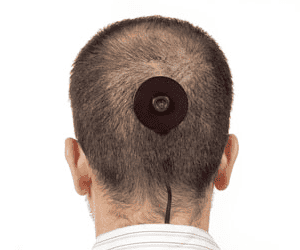The Lifelogging Professor – An Update on the Surgically Implanted Camera

Share
I don’t know artist Wafaa Bilal, but I know exactly where he was about an hour ago. How? The constant stream of photos being automatically taken from a camera on his body and uploaded to the Internet, of course. That, and the latitude and longitude of his location, as well as a handy Google map displaying his location – all of which is displayed on the website for his current project, The 3rdi. Based on the PowerPoint being set up, I know that he gave a presentation around 7pm EST. After, he went to a coffee shop in New York City's West Village and relaxed a while, which is obvious from the photos of people reading and working on their computers behind him. If you were in the area, you may have been one of them. You may have heard about this NYU photography professor back in November when he underwent a surgery (of sorts) to implant the camera in the back of his head. Recently some medical complications resulted in removal of part of the device but, as they say, the show must go on.
Indeed it has. In addition to the website, the photos are also being displayed in real time at the Mathaf Arab Museum of Modern Art in Doha, Qatar as part of the Told/Untold/Retold exhibition. The exhibition brings together 23 artists, and claims to be the largest contemporary art museum exhibit of its kind in the Arab world. “The exhibition invites you to look at artists, not as national representatives but as 'transmodern' artists in consistent metamorphosis.” Metamorphosis indeed. Bilal underwent the surgical procedure at a tattoo and body-piercing studio in Los Angles after doctors refused to perform the procedure. A titanium base was implanted between the skin and skull, using only local anesthesia. Ouch. Just a couple months after the procedure, he removed part of the device after his body rejected one of the three titanium posts that held the camera in place. Undeterred, Prof. Bilal is forging ahead and wearing the camera on a strap around his neck. The camera is still facing backwards, and is still capturing photos every minute and publishing them to the project’s website.
Be Part of the Future
Sign up to receive top stories about groundbreaking technologies and visionary thinkers from SingularityHub.


In the last hour, the images displayed on the 3rdi website have gone from the coffee shop to darkness which likely means that Bilal either went to bed, or that he is on NYU’s campus. Yep – while the photography professor is on NYU’s campus or teaching, the school’s administration requires him to cover the camera to protect students’ privacy. In a world where we might unsuspectingly receive a traffic ticket for running a red light, along with photographic evidence taken of us at the time, Bilal’s project seems to be just another one of the many opportunities for our images to be recorded. If Wal-Mart suspects you of being a shoplifter, they simply check the video footage that captured the goings on of the day. If you had a hunch that the guy next to you on the subway was picking his nose but didn’t want to visually confirm – somebody probably filmed it.
As technology evolves, the tools we use to capture images get smaller and more sophisticated and the data becomes easier to store. The result? We are probably going to see a lot more of this type of thing, and not always for the sake of art. Maybe one day if you misplace your keys, you will be able to visually retrace your steps by scanning through the images that your brain saw that day. Now really, that seems like crazy talk. If you consider the advancements in implantable microchips and neuroscience though, the idea of uploading what you see everyday to your computer suddenly doesn’t sound so Sci Fi. And Wafaa Bilal is paving the way. As Oscar Wilde once said “Life imitates Art far more than Art imitates Life” – so prepare yourselves, and by that I mean, smile! You might be on camera at this very moment.
[image credits: wafaabilal.com, www.3rdi.me]
[Source: www.3rdi.me, wafaabilal.com]
Whitney's thesis research revolved around creating a 3D patch of skeletal muscle tissue from stem cells and much more.
Related Articles

This Week’s Awesome Tech Stories From Around the Web (Through December 13)

New Immune Treatment May Suppress HIV—No Daily Pills Required

How Scientists Are Growing Computers From Human Brain Cells—and Why They Want to Keep Doing It
What we’re reading

